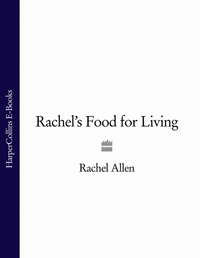
Полная версия
Recipes from My Mother
Crab and sweetcorn chowder
SERVES 4–6
A chowder is more than just a soup, it’s a meal in a bowl, and this version with delicious sweet-salty crabmeat and corn is a keeper. Needless to say, the better the crabmeat, the more delicious this will be. If you can get hold of some brown crabmeat along with the white, the flavour will be even better.
30g (1¼oz) butter
200g (7oz) onions, cut into 1cm (½in) dice
2 garlic cloves, chopped
300g (11oz) potatoes, cut into 1cm (½in) dice
600ml (1 pint) hot chicken, fish or vegetable stock
200g (7oz) sweetcorn kernels
200ml (7fl oz) milk
150g (5oz) white crabmeat
pinch of cayenne pepper
1 tbsp lemon juice
2 tbsp chopped parsley
2 tsp chopped tarragon
50ml (2fl oz) regular or double cream
sea salt and freshly ground black pepper
To serve
fresh bread
1. Melt the butter in a saucepan over a gentle heat, then add the onions and garlic with a little salt and pepper. Cover and allow to sweat until soft but not coloured. Add the potatoes and cook for a further 5–10 minutes, stirring occasionally so that they don’t brown.
2. Next, add the stock, sweetcorn and milk, and bring to the boil, then lower the heat and simmer until the potatoes are cooked through and are just beginning to thicken the soup.
3. Finally, add the crabmeat, cayenne pepper, lemon juice, chopped herbs and cream. Bring the chowder back up to a gentle simmer, then serve with lots of lovely bread.
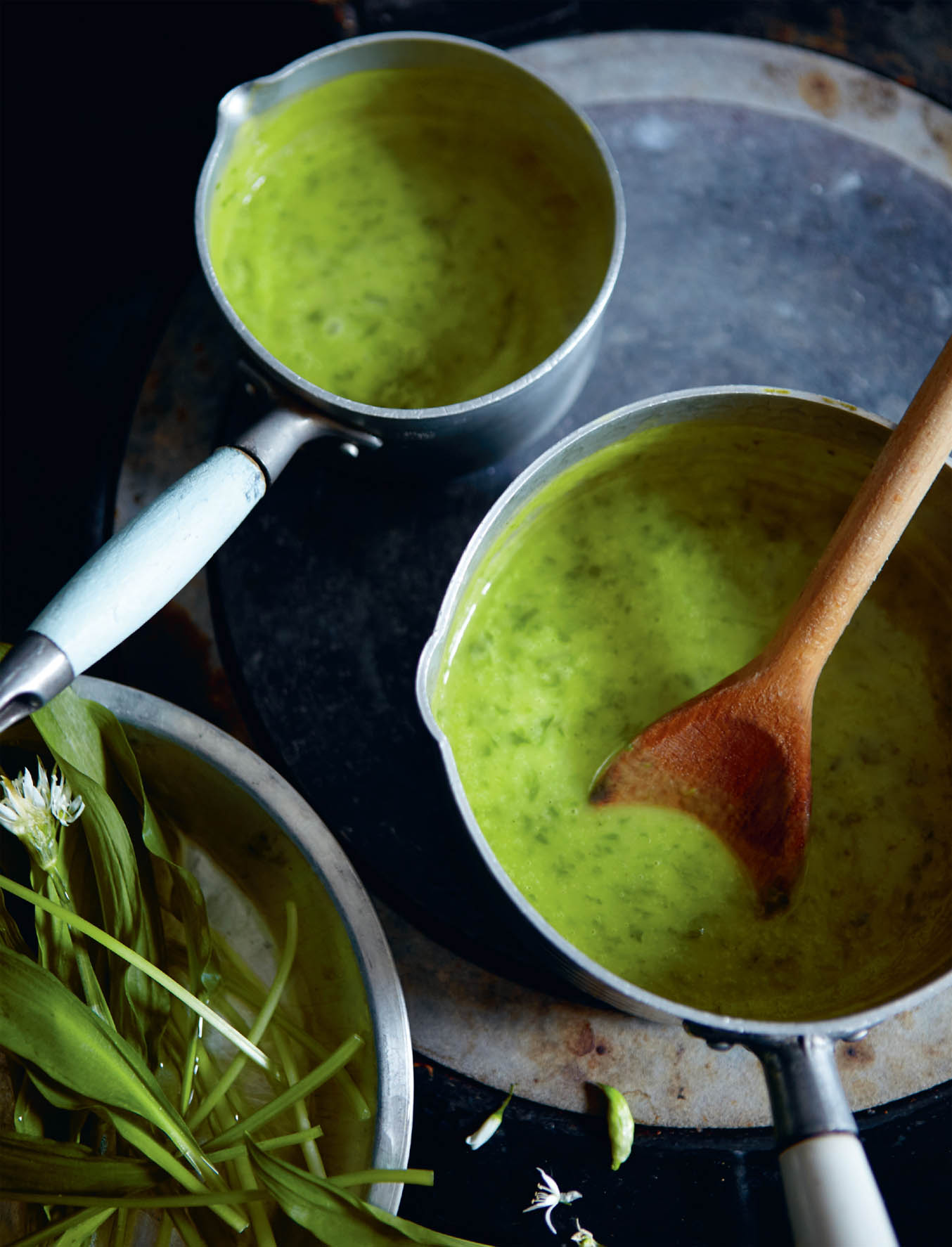
Wild garlic soup
SERVES 6
A vibrant green soup that makes you feel good just looking at it, not to mention eating it! Use the wide-leaf wild garlic, ramson, or the three-cornered leek with the narrow leaves, both in season in spring. At other times of the year, or if you can’t get hold of any wild garlic, you can replace it with watercress, young nettles (wear gloves when harvesting – the sting will go once cooked!), spinach, kale or chard.
25g (1oz) butter
2 potatoes, diced
1 onion, chopped
1 litre(1¾ pints) chicken or vegetable stock
2 large handfuls of wild garlic leaves, roughly chopped
110ml (4fl oz) regular or double cream
sea salt and freshly ground black pepper
To serve
crusty bread
1. Melt the butter in a large saucepan over a medium heat. When foaming, add the potatoes and onion, and toss in the butter until well coated, then season with salt and pepper. Turn the heat down, cover the pan and cook for 10 minutes or until the vegetables are soft, stirring regularly so that the vegetables don’t stick and burn.
2. Next, add the stock and bring to a rolling boil, then add the wild garlic leaves and cook for 2 minutes or until the leaves have wilted. Don’t overcook the soup at this stage or it will lose its fresh green colour and flavour.
3. Immediately pour into a blender and whiz until smooth, then return to the clean pan, stir in the cream and taste for seasoning.
4. Serve hot with crusty bread.
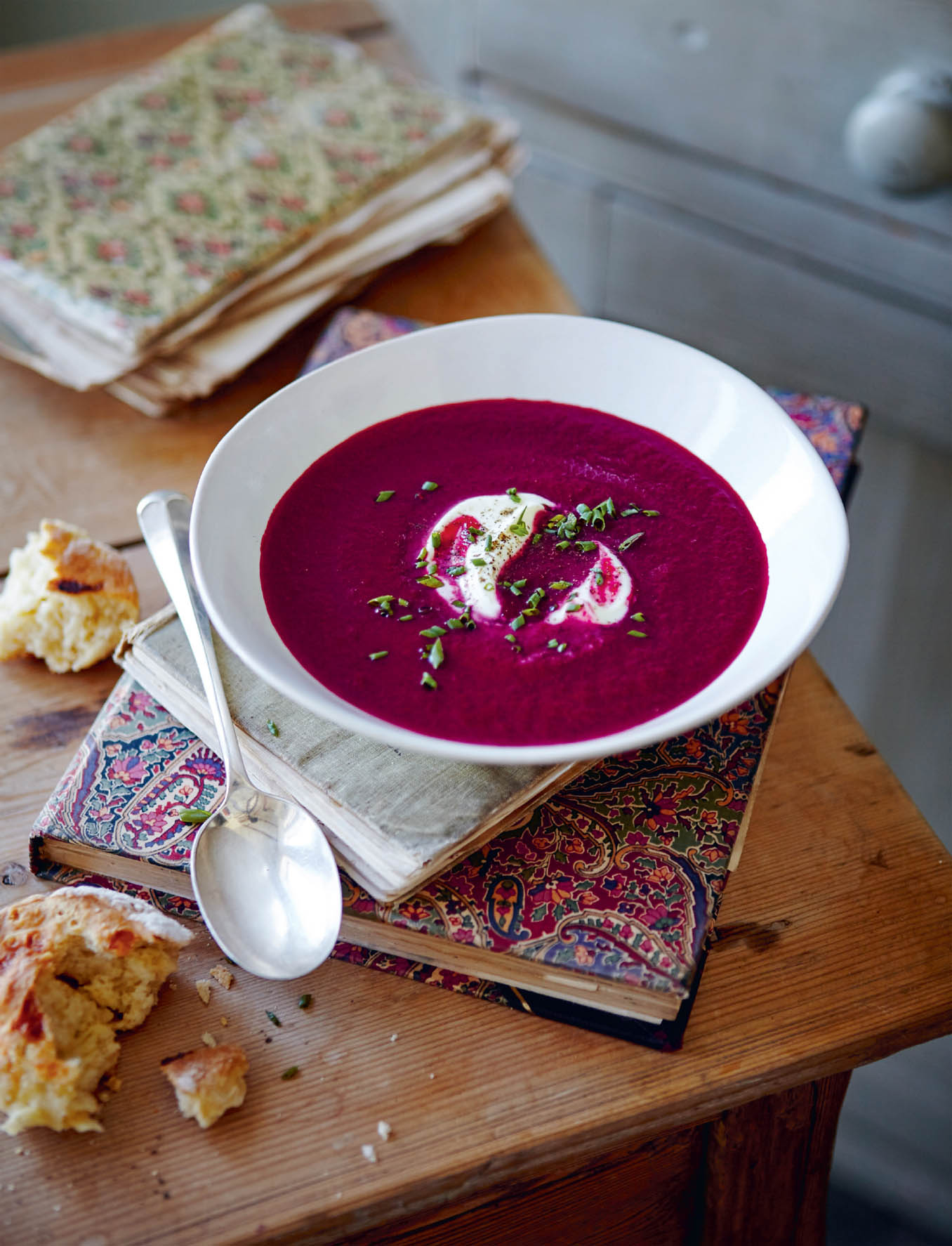
Beetroot soup with chives
SERVES 8–10
I remember my mum started making beetroot soup for dinner parties in the 1980s and back then I thought the vivid pink concoction was the epitome of chic. I still do, and love it that something so stunningly pretty can be that good for you.
900g (2lb) whole raw beetroot
25g (1oz) butter
225g (8oz) onions, chopped
1.2 litres (2 pints) chicken or vegetable stock
110ml (4fl oz) cream or milk, or a mixture
sea salt and freshly ground black pepper
To serve
110g (4oz) sour cream or crème fraîche
2 tbsp finely chopped chives
1. Remove the leaves from the beetroot (use these for another recipe), then cut off most of the stalk, leaving about 2cm (¾in) still attached to the root. Leave the tails of the beetroot intact. Wash the beetroot carefully under a cold tap. Do not scrub them – simply rub off any dirt with your fingers. You don’t want to damage the skin or to cut off the top or tails, otherwise the beetroot will ‘bleed’ while cooking, losing important nutrients.
2. Place the beetroot in a saucepan and cover with cold water and a pinch of salt. Place over a medium heat and bring to a simmer. Cover, then continue to simmer for 30 minutes–2 hours, depending on the size and age of your beetroot. They are cooked when their skins rub off easily and a knife just slides into the centre.
3. While the beetroot cooks, melt the butter in a large saucepan over a low heat. When melted, add the onions and season with salt and pepper. Cover and cook for 8–10 minutes until soft but not coloured.
4. When the beetroot is cooked, rub off the skins and discard, then cut into chunks. Add to the onions with the stock. Bring to a rolling boil, then pour into a blender and whiz until it is quite smooth (be careful, beetroot will stain). Return to the pan over a medium heat, stir in the cream and/or milk, then taste and adjust the seasoning.
5. Serve hot, topped with a spoonful of sour cream or crème fraîche and a scattering of chives.
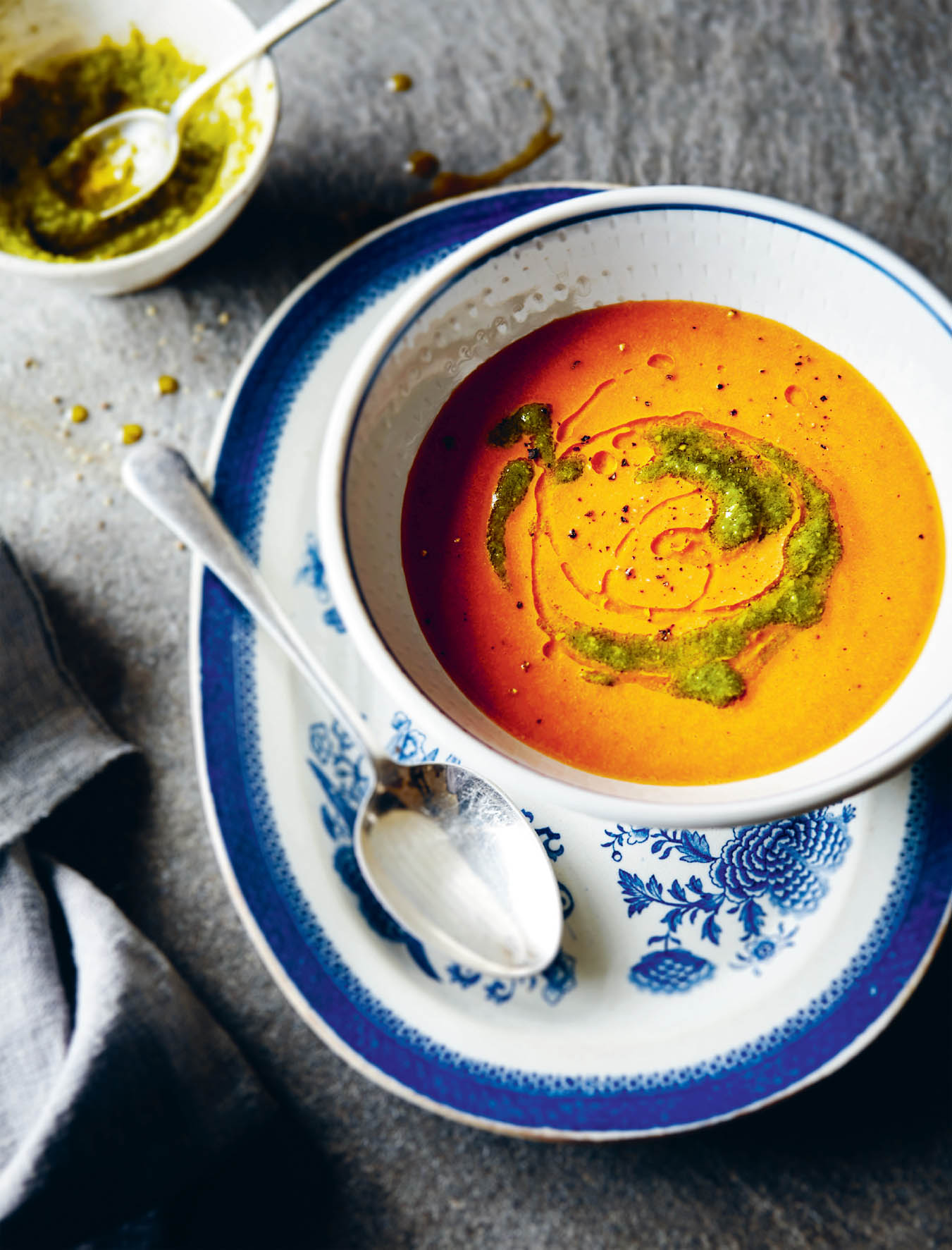
Almost-instant tomato and basil soup
SERVES 4
A delicious fresh-tasting soup that’s super-quick to make, this is like summer in a bowl. Like many soups, it can be frozen, too, for a taste of summer in any season!
25g (1oz) butter
125g (4½oz) white parts of spring onions, chopped (keep the green tops for another recipe)
1 garlic clove, chopped
400g (14oz) very ripe tomatoes, chopped or 1 × 400g tin chopped tomatoes
generous pinch of sugar
400ml (14fl oz) hot vegetable or chicken stock
50ml (2fl oz) regular or double cream
sea salt and freshly ground black pepper
To serve
1 tbsp chopped basil or 4 tsp basil pesto
1. Melt the butter in a saucepan over a medium heat, then add the spring onions and garlic and season with salt and pepper. Cover the pan and sweat the onions for 5 minutes. Add the tomatoes and sugar. Turn up the heat and bring to the boil, then turn the heat down and simmer for 5 minutes. Add the stock, bring to the boil, then turn down the heat and simmer for a further 5 minutes. Add the cream and simmer for just 1 minute.
2. Transfer to a blender and whiz really well. Pour the soup through a fine sieve into a clean pan and gently reheat but do not boil the soup.
3. To serve, stir in the chopped basil or drizzle the basil pesto over each bowl.
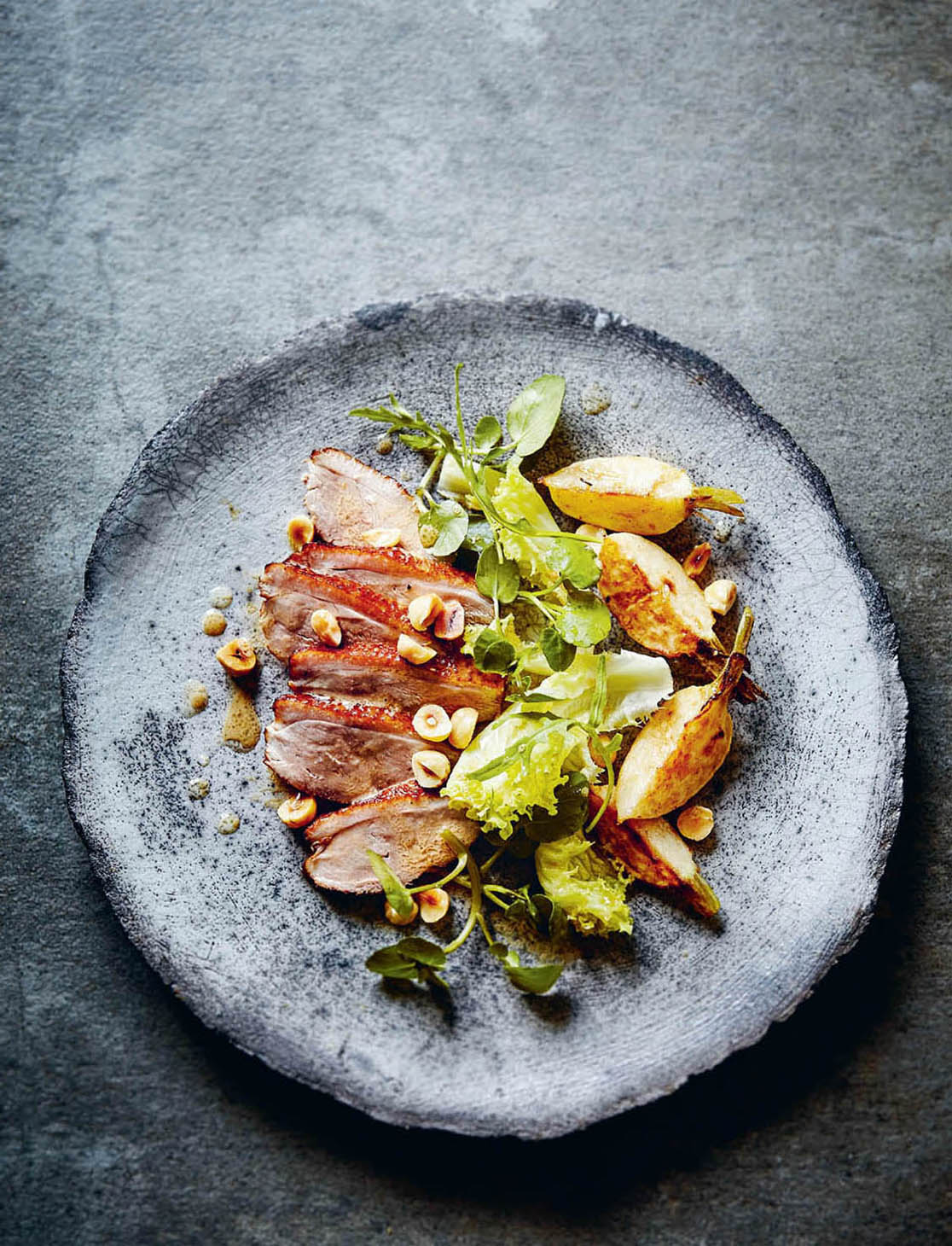
Warm salad of hot-smoked duck, glazed navettes and toasted hazelnuts
SERVES 4
Duck reacts so well to a bit of hot smoke – the rich flavour of the meat is enhanced by its full-bodied aroma and the lovely layer of fat under the skin ensures the meat does not dry out during smoking. The little white turnips, called navettes, end up tender and coated in a delicious glaze set against the welcome crunch of the hazelnuts.
32 hazelnuts, chopped into 2 or 3 pieces and toasted (see tip)
4 navettes (small white turnips), cut into 6 or 8 wedges
15g (½oz) butter
2 duck breasts
4 good handfuls of bitter greens (watercress, rocket, mustard leaf, frisée)
sea salt and freshly ground black pepper
For the dressing
1 tbsp good-quality sherry vinegar
3 tbsp hazelnut or walnut oil
1 tsp Dijon mustard
1. Place all the dressing ingredients in a bowl, season with salt and pepper and whisk well to combine. Set aside.
2. Place the navettes in a flameproof casserole or small saucepan. Add 3 tablespoons water and the butter, and season with salt and pepper. Cover with a tight-fitting lid and cook for 20 minutes over a medium heat. Check the navettes while they are cooking and remove the lid for the last few minutes of cooking time if there is still a lot of liquid in the casserole. They should be glazed but not wet.
3. Meanwhile, following the instructions for the Biscuit-Tin-Smoked Fish, put your duck breasts into the biscuit-tin smoker to smoke for 20 minutes while the navettes are cooking.
4. When the duck is smoked and the navettes are cooked, slice the duck breasts. Arrange the sliced duck and navette wedges in a circle around the edge of four warm plates, leaving a space in the middle of each plate for the salad.
5. Dress the bitter greens with most of the dressing and divide among the plates. Sprinkle with the toasted hazelnuts and drizzle with the remaining dressing. Serve immediately.
TIP
Tip the hazelnuts into a non-stick frying pan and toast over a high heat for 1–2 minutes until golden, tossing regularly to avoid burning. Take off the heat and set aside to cool.
Salad of smoked fish with lamb’s lettuce and a crispy egg
SERVES 4
A gorgeously substantial salad, this has all the elements of a summer main course that I love – delicious fresh leaves, smoky tender fish and a softly boiled egg encased in a crispy breadcrumb coating. Use really good extra-virgin olive oil here.
4 × 200g (7oz) fillets of fish – smoked haddock or coley, either hot-smoked (see Biscuit-Tin-Smoked Fish), or shop-bought cold-smoked fish
a little butter
4 handfuls of lamb’s lettuce or any other delicious salad leaves
For the dressing
2 tsp Dijon mustard
2 tsp white wine vinegar
2 tbsp extra-virgin olive oil
sea salt and freshly ground black pepper
For the crispy eggs
4 eggs, plus 1 beaten egg
2 tbsp plain flour, seasoned with salt and pepper
3 tbsp panko or fine white breadcrumbs
sunflower oil, for shallow-frying or deep-frying
1. To make the crispy eggs, bring a large pan of water to the boil, then add the eggs (they need to be completely submerged), set a timer and allow to boil for exactly 5 minutes. Using a slotted spoon, remove the eggs and cool under cold running water to prevent them cooking further.
2. Place the seasoned flour, beaten egg and the breadcrumbs in three separate shallow dishes. Peel the eggs carefully, as they will still be soft in the centre, roll them in the flour, then in the beaten egg and, finally, in the crumbs to give them a nice coating. Set aside.
3. Cook your fish – either follow the hot-smoked biscuit-tin recipe, or pan-fry the cold-smoked fish in a little butter.
4. While the fish is cooking, heat a little sunflower oil for the crispy eggs in a small pan and shallow-fry the eggs, turning frequently, until they are golden and crispy all over, or deep-fry them in sunflower oil.
5. Whisk together all the ingredients for the dressing. Put the lamb’s lettuce in a bowl and sprinkle with a few teaspoons of the dressing, then toss – the leaves should be lightly coated but not too much.
6. Place the cooked fish in the centre of each plate, then place a crispy egg on top. Arrange the dressed leaves around each one in a ring, drizzle the whole plate with more dressing and serve.
Roast beetroot salad with liquorice, goat’s cheese and candied pearl barley
SERVES 4
This salad is inspired by a recipe that the wonderful cookery writer Diana Henry wrote on her return from my mother’s home town of Reykjavik. Liquorice is one of my mum’s favourite flavours from growing up in Iceland and this is an intriguing method of cooking it with beetroot. It adds a subtle, spicy sweetness, but you can leave it out if you prefer.
400g (14oz) even-sized raw beetroot, whole and unpeeled
2 sticks (20g/¾oz) broken liquorice root
4 handfuls of salad leaves, including some small beetroot leaves, if possible
150g (5oz) soft goat’s cheese
For the candied pearl barley
50g (2oz) pearl barley
50g (2oz) brown sugar
pinch of sea salt
For the dressing
4 tbsp extra-virgin olive oil
4 tbsp walnut oil
1 tbsp honey
2 tbsp cider vinegar
1 tbsp Dijon mustard
sea salt and freshly ground black pepper
1. Remove the leaves from the beetroot and cut off most of the stalk, leaving about 2cm (¾in) attached. Leave the tails intact. Wash under a cold tap – do not scrub, simply rub off any dirt with your fingers. You don’t want to damage the skin, otherwise the beetroot will ‘bleed’ while cooking, losing important nutrients.
2. Put the beets in a saucepan large enough to fit them all in a tight single layer, add the liquorice and just cover with water – do not add salt. Cover, place on the hob and bring to the boil, then turn the heat down and simmer for ¾–1 hour until cooked. The skin should peel easily and a knife slide into the centre.
3. Using a slotted spoon, remove the beetroot and set aside until cool enough to handle. Return the pot to the hob and allow the beetroot cooking water to bubble with the lid off until reduced to a quarter of its original volume. Discard the liquorice.
4. While the beets cook, toast the pearl barley in a pan over a medium heat, shaking frequently until it turns a light nutty brown. Remove from the pan and set aside.
5. Sprinkle the brown sugar into the dry pan, return to the heat and, without stirring, allow to dissolve. When the sugar has dissolved, return the pearl barley to the pan with a pinch of salt. Shake the pan or swirl gently to coat the pearl barley with caramel and then pour it out onto a piece of baking parchment. Set aside to cool.
6. Next, make the dressing. Mix the oils, honey, vinegar and mustard in a bowl with a pinch of salt. Set aside.
7. Preheat the oven to 200°C (400°F), Gas mark 6. When cool, peel the beets and cut into wedges. Toss in a little dressing and roast for 10 minutes.
8. Loosen the remaining dressing with 1 tablespoon of the beetroot cooking liquid. Dress the leaves, divide among four plates in a ‘nest’ in the centre of each. Alternate wedges of beetroot and blobs of cheese around the leaves. Chop the candied pearl barley and sprinkle over, drizzle with the remaining dressing and serve.
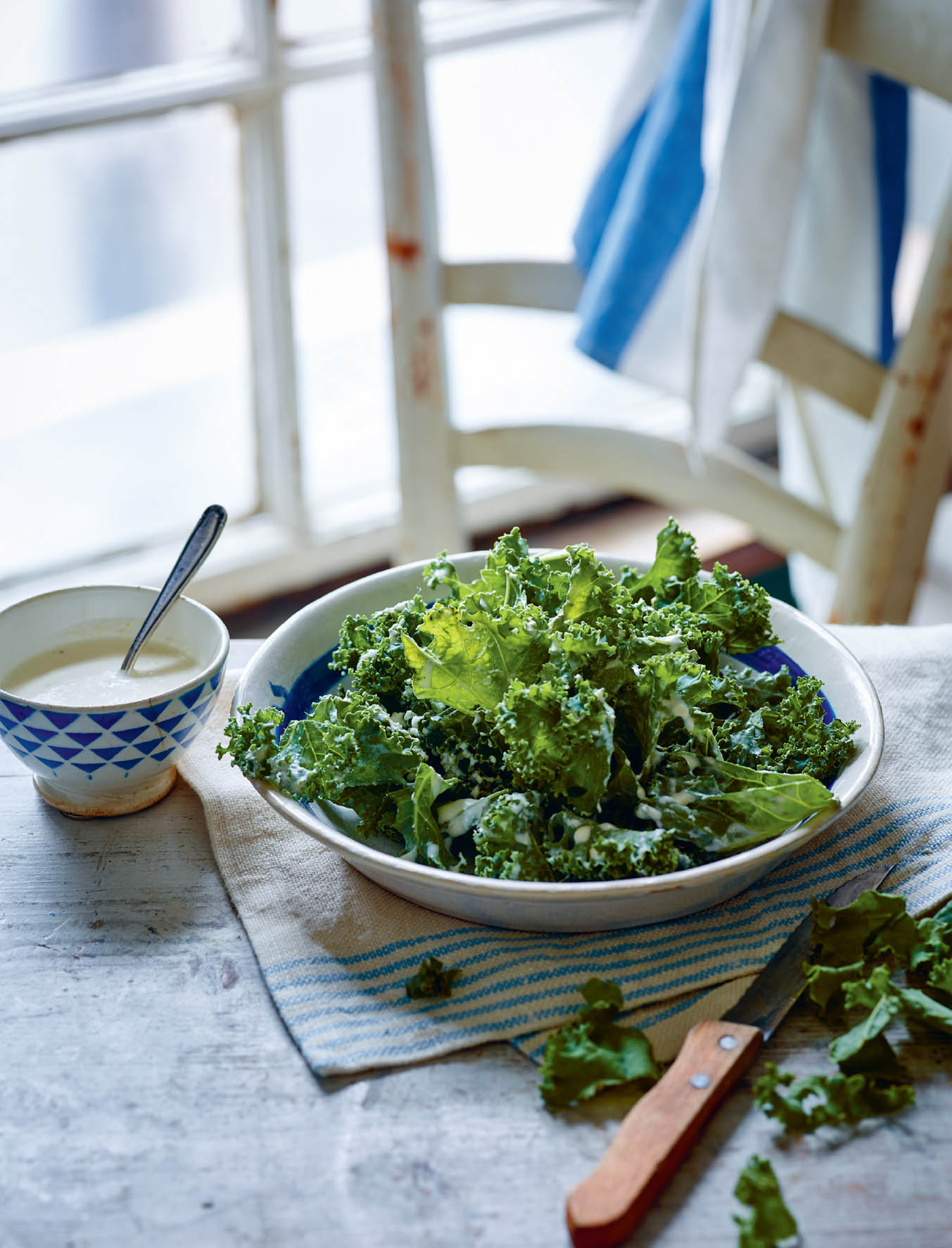
Scandi kale salad with horseradish
SERVES 4–6
A lovely simple salad with Scandi flavours that uses lots of nutritious raw kale. The deliciously hot/sweet/tangy dressing is also super tossed with raw grated beetroot, carrot and celeriac, slaw-style.
200g (7oz) de-stalked kale leaves, roughly chopped
For the dressing
175g (6oz) crème fraîche
120ml (4fl oz) lemon juice
2½ tbsp finely grated horseradish
40g (1½oz) sugar
pinch of sea salt
1. Place the kale leaves in a bowl.
2. To make the dressing, whisk together the crème fraîche, lemon juice, horseradish and sugar, and season with a pinch of salt. Add the dressing to the kale and toss to combine.
Beetroot and coriander hummus
MAKES 450ml (16fl oz)
1 raw beetroot, peeled and cut into chunks
1 × 400g tin of chickpeas, drained and rinsed
2 garlic cloves, crushed
2 tbsp light tahini (sesame seed paste)
3 tbsp extra-virgin olive oil, plus extra if needed
juice of ½–1 lemon, to taste
2 tbsp chopped coriander
sea salt and freshly ground black pepper
1. Place the beetroot chunks, chickpeas, garlic and tahini into a food processor, pour in the olive oil, then pulse until smooth. Add the lemon juice and the chopped coriander then season to taste with salt and pepper. If the hummus is a bit too thick, add a little more olive oil.
2. The hummus will keep in the fridge in a sealed container for three to four days. Use as a dip for raw vegetable sticks or pitta bread, or as a salad dressing.
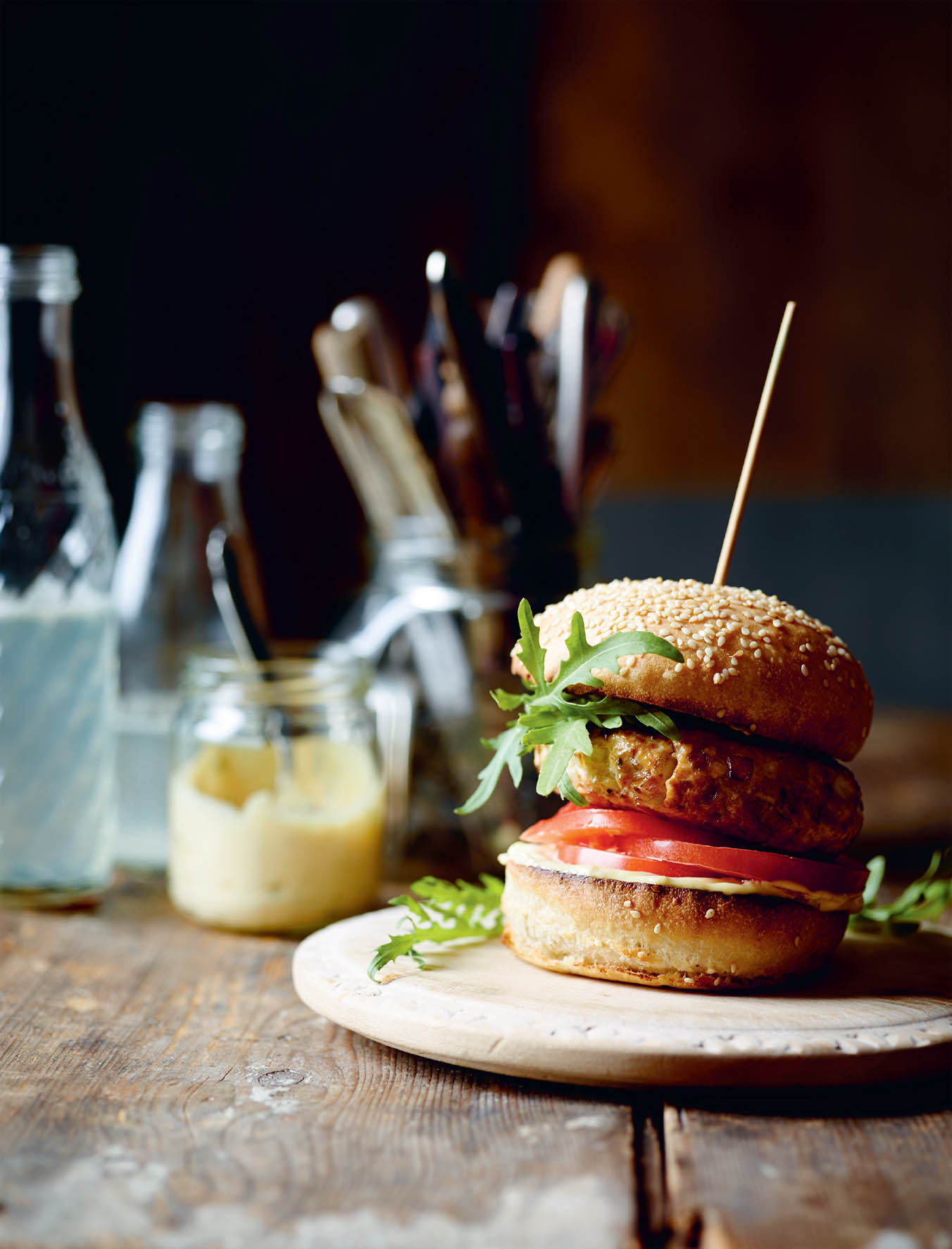
Chicken burger with lemon and chive mayonnaise
MAKES 6–8 BURGERS
This is comfort food in a bun. It’s up to you whether you use brown or white meat for mincing, but I find that a mixture of the two works well to give a deliciously flavoursome and juicy burger. The lemon and chive mayonnaise is the perfect accompaniment.
25g (1oz) butter
300g (11oz) shallots, finely sliced, or 1 red onion, finely chopped
4 garlic cloves, crushed
2 tbsp chopped thyme
900g (2lb) minced chicken
zest of 1 lemon
1–2 tbsp extra-virgin olive oil
salt and freshly ground black pepper
For the lemon and chive mayonnaise
2 tbsp snipped chives
2 tbsp of lemon juice, plus extra to taste
1 tsp Dijon mustard
generous pinch of salt
2 egg yolks
50ml (2fl oz) extra-virgin olive oil
150ml (5fl oz) sunflower oil
To serve
Buttermilk Burger Buns
fresh rocket
slices of ripe tomatoes
1. First make the mayonnaise. Put all the ingredients, except the oils, in a glass bowl (a stainless-steel bowl can give the mayonnaise a grey colour). Mix the oils in a jug. Continuously whisk the mixture in the bowl while adding the oil slowly in a thin, steady stream until it is completely combined to a smooth, creamy texture. Taste for seasoning and add an extra splash of lemon juice if necessary. (For speed, you can use an electric hand whisk.) Cover and chill while you make the burgers.
2. Melt the butter in a saucepan, then add the shallots or onion, the garlic, thyme, and salt and pepper to taste. Put the lid on the pan and sweat over a gentle heat until the onions are soft but not coloured. Remove from the heat and allow to cool.
3. Combine the minced chicken, cooled onion mixture and the lemon zest in a bowl and season with salt and pepper. Break off a small piece and fry it in a little oil, then taste it and adjust the seasoning if needed.
4. Use your hands to shape the mixture into 6 large or 8 medium burgers, each with a thickness of roughly 2cm (¾ in) – having wet hands makes this much easier to do.
5. Preheat a griddle or frying pan over a high heat, then turn the heat down to medium and add the olive oil. Fry the burgers for 8–10 minutes on each side to cook through, turning the heat down to low once the burgers are golden on both sides. You may need to do this in two batches, adding more olive oil when frying the second batch. (You can finish them in the oven preheated to 200°C (400°F), Gas mark 6 for 5–8 minutes until cooked through, if you want to.)
6. Serve in a bun with some rocket, tomato slices and a good blob of the lemon and chive mayonnaise.
Pork burgers
MAKES 6–8 BURGERS
The fresh, summery mayonnaise works a treat with this great pork burger.
900g (2lb) minced pork
150g (5oz) spring onions, finely chopped
2 garlic cloves, crushed
1–2 tbsp extra-virgin olive oil
6–8 slices of mozzarella cheese
sea salt and freshly ground black pepper
For the tomato and basil mayonnaise
2 tsp tomato purée
1 tsp Dijon mustard
1 tbsp chopped basil
1 tbsp red wine vinegar
pinch of sea salt
2 egg yolks
50ml (2fl oz) extra-virgin olive oil
150ml (5fl oz) sunflower oil
To serve
Buttermilk Burger Buns
cucumber slices
1. First make the mayonnaise. Put all the ingredients, except the oils, in a glass bowl (a stainless-steel bowl can give the mayonnaise a grey colour). Mix the oils in a jug. Continuously whisk the mixture in the bowl while adding the oil slowly in a thin, steady stream until it is completely combined to a smooth, creamy texture. Taste for seasoning. (For speed, you can use an electric hand whisk.) Cover and chill while you make the burgers.
2. Next make the burgers. Mix the pork, spring onions, garlic, and salt and pepper in a bowl. Break off a small piece and fry it in a little oil, then taste it and adjust the seasoning if needed.
3. Use your hands to shape the mixture into 6 large or 8 medium-sized burgers, l–2cm (½–¾in) thick.
4. Place a frying pan over a medium heat and heat the olive oil. Fry the burgers for 8–10 minutes on each side over a medium-low heat. You may need to do this in two batches, adding more olive oil when frying the second batch. When the burgers are nearly cooked, place a slice of mozzarella cheese on each burger, cover the pan with a lid and cook until the cheese has melted.
5. Serve in a fresh bun with some sliced cucumber and a blob of tomato and basil mayonnaise.
Beetroot and hazelnut slaw
SERVES 6–8
A slaw is just the thing to serve with rich meats at a barbecue, or indeed burgers. It’s both a salad and a sauce that’ll bring freshness and crunch.
225g (8oz) raw beetroot, peeled and grated
225g (8oz) carrot, grated
3 tbsp chopped mint or parsley
¼ head of savoy cabbage
4 tbsp hazelnut oil or extra-virgin olive oil
2 tbsp lemon juice
2 tsp Dijon mustard
110g (4oz) hazelnuts, toasted and roughly chopped (see tip, here)
sea salt and freshly ground black pepper
1. Place the grated beetroot and carrot and the chopped mint or parsley in a large bowl. Remove the dark outer leaves from the cabbage, cut out and discard the core and shred the leaves as thinly as possible, cutting across the quartered head. Add the cabbage to the bowl.
2. In a small bowl, combine the oil and lemon juice with the Dijon mustard, then season with salt and pepper. Pour the dressing onto the vegetables and herbs and mix well until evenly coated.
3. Transfer to a serving bowl or plate, scatter over the toasted hazelnuts and serve.
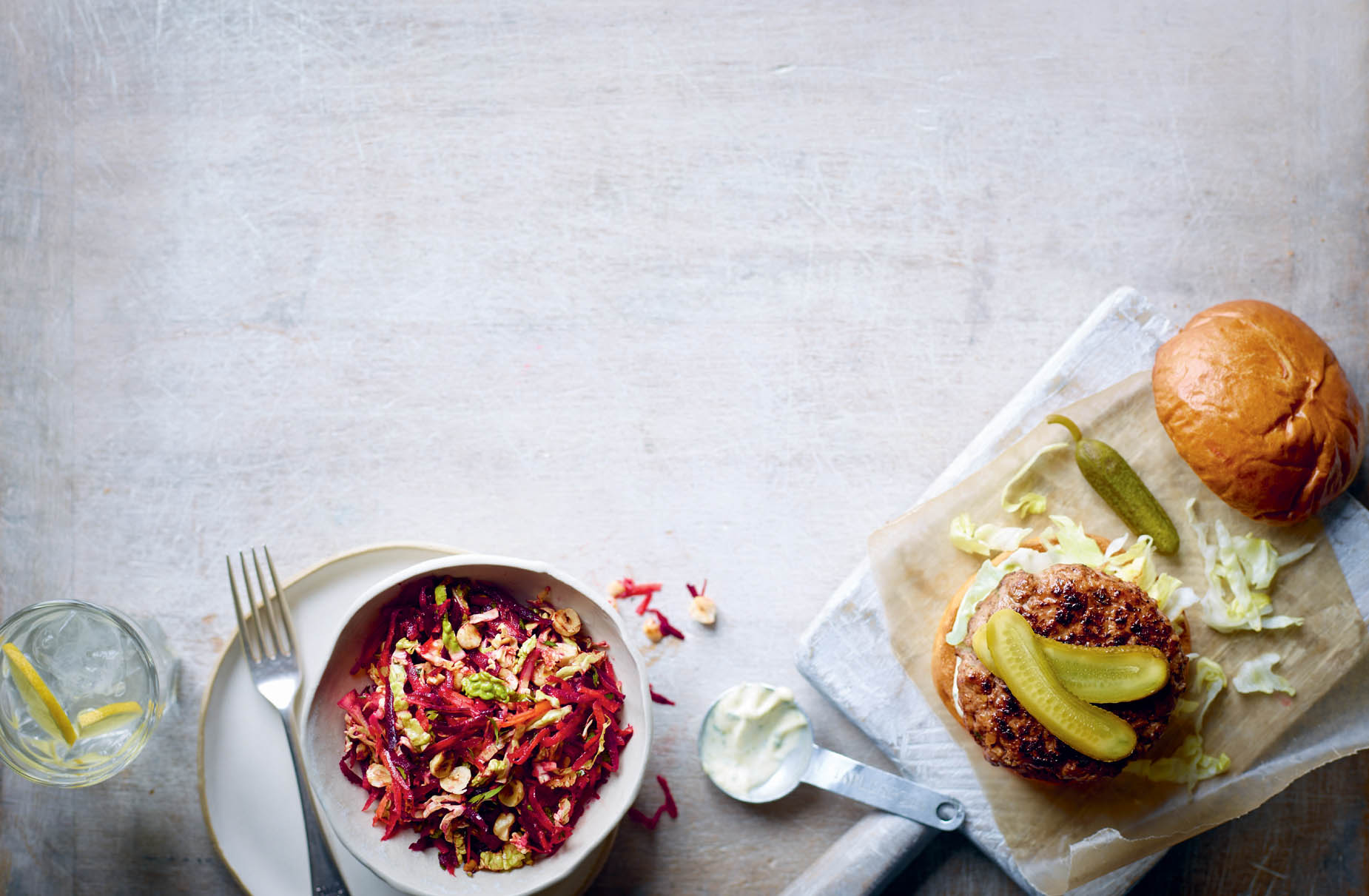
Beef burgers
MAKES 6–8 BURGERS
Every committed carnivore needs a decent burger recipe in their repertoire, and this simple beef burger should tick the box for you. The horseradish and tarragon mayonnaise is super with a steak or lamb chops, too.
25g (1oz) butter
300g (11oz) onions, finely chopped
900g (2lb) minced beef
2 tbsp chopped thyme, marjoram and parsley (preferably a mixture)
1 egg, beaten
1–2 tbsp extra-virgin olive oil
sea salt and freshly ground black pepper
For the horseradish and tarragon mayonnaise
2 tsp finely grated fresh horseradish
2 tsp Dijon mustard
2 tsp chopped tarragon
1 tbsp cider vinegar
pinch of salt
2 egg yolks
50ml (2fl oz) extra-virgin olive oil
150ml (5fl oz) sunflower oil
To serve
Buttermilk Burger Buns
sliced lettuce and gherkins
1. First make the mayonnaise. Put all the ingredients, except the oils, in a glass bowl (a stainless-steel bowl can give the mayonnaise a grey colour). Mix the oils in a jug. Continuously whisk the mixture in the bowl while adding the oil slowly in a thin, steady stream until it is completely combined to a smooth, creamy texture. Taste for seasoning. (For speed, you can use an electric hand whisk.) Cover and chill while you make the burgers.








